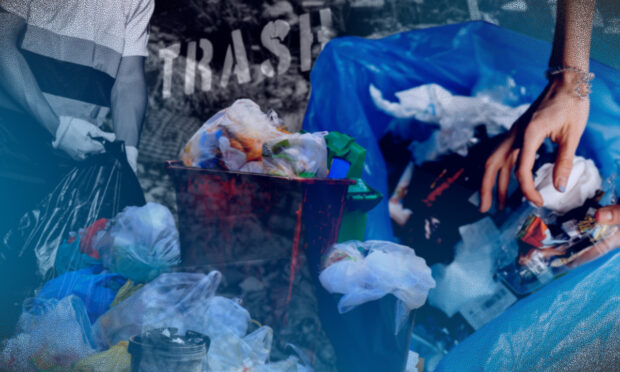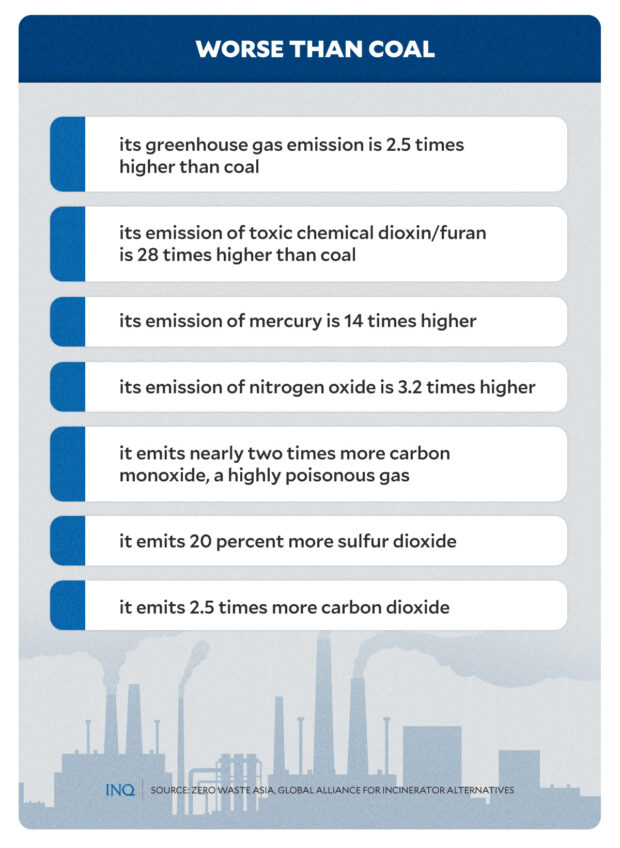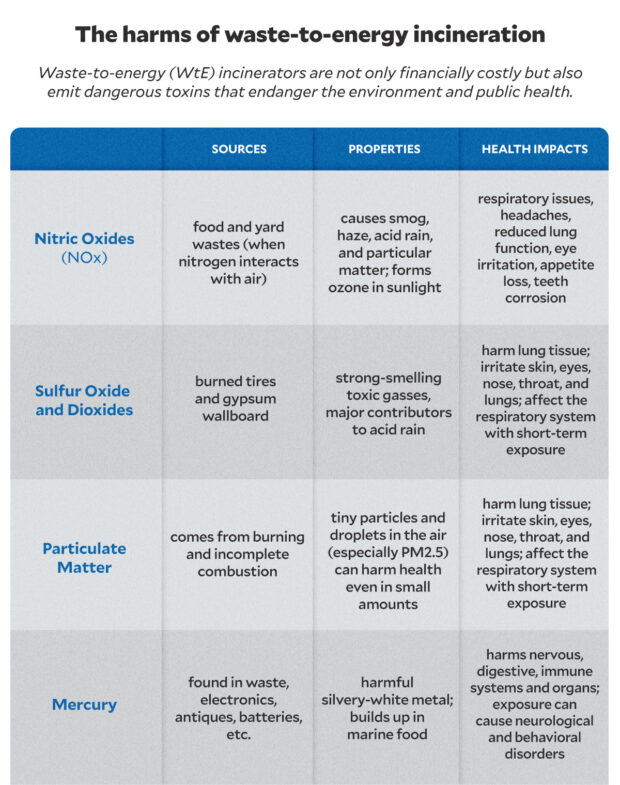Waste energy: ‘False solution’

First part: Risks loom as worsening garbage mess pushes deep PH dive into waste-to-energy
MANILA, Philippines — Years worth of studies, alongside government reports and statistics, have painted a concerning picture of the Philippines grappling with a hefty challenge in managing its solid waste.
Every year, the unstoppable wave of waste grows, posing a serious threat to the country’s landfills, which are already struggling to accommodate the vast amounts of waste produced across the nation. This puts them at risk of becoming overwhelmed and potentially inoperative in the near future.
READ: Running out of landfills
Faced with the daunting task of managing the burgeoning piles of waste and dwindling space in landfills, the government is now venturing into the realm of waste-to-energy (WTE) as a solution.
WTE, as defined by the Department of Environment and Natural Resources (DENR) in an administrative order issued in 2019, refers to the process of converting wastes using various technologies.
The process involves the conversion of non-recyclable waste materials into reusable heat, electricity, or fuel “through a variety of processes” — usually through incineration.
The DENR considers WTE as a “cleaner and more suitable alternative” to the traditional sanitary landfill, which is the allowed waste disposal method under Republic Act (RA) No. 9003 or the Ecological Solid Waste Management Act of 2000.
The Department of Energy (DOE) recognizes that WTE facilities “simultaneously achieve the twin socio-economic benefits on Local Government Units’ (LGUs) solid waste management and the provision of an additional source of power supply.“
Waste-to-energy bill
In a bid to push further the move towards the use of WTE technology in the country, legislations such as the proposed Waste-to-Energy Act or Senate Bill 2267 have been filed in Congress, stressing the need to establish WTE plants in the country.
According to the bill’s sponsor, Senator Raffy Tulfo — who also serves as chairperson of the Senate Committee on Energy — WTE plants do not only promote proper waste management but also have “great potential” as a source of renewable energy in the country.
In a sponsorship speech delivered last year, Tulfo stressed that many countries — such as Japan, Sweden, South Korea, and Singapore — have long been relying on WTE technology.
“Let us weigh the advantage of opening our doors to this technology that creates energy out of our waste. Other countries will not use this without considering its risks and problems,” he said.
Based on findings by the international zero waste advocacy group Global Alliance for Incinerator Alternatives (GAIA), there are already 1,120 WTE plants in the Asia Pacific Region.
Albrecht Arthur N. Arevalo, Climate and Anti-Incineration Campaigner for GAIA Asia Pacific, said more than 2,700 thermal WTE plants will be onsite globally by 2028 — 200 of those are emerging in Asia Pacific countries, including China, Thailand, the Philippines, Indonesia, Myanmar, Malaysia, Maldives, and Vietnam.
Data from DOE showed that 13 WTE plants and projects are already registered under RA 9513, the Renewable Energy Act of 2008 — of those, six are already operational, and seven are marked as ongoing projects.
However, Arevalo stressed that there is still an even bigger picture behind the ongoing trend of energy transition or plans to retire coal-fired power plants and move towards the use of WTE technology in the Asia Pacific region.
Asia is the new market, but why?
“The trend now globally is that different countries, which used to take up incinerators, are now seeing [WTE’s] non-viability and non-sustainability,” Arevalo said during the International Zero Waste Month Symposium held last January 27 in Malaysia.
Arevalo pointed out that in the United States, 50 incinerators have closed for good between 2000-2023, citing the lack of finance required for upgrades.
“With other countries formerly jubilant about incinerators now moving away from them, we are now seeing a move towards Asia as a new market for these tech fixes,” he said.
The Asian countries with the most waste incinerators include Japan, mainland China, and South Korea. Singapore, although it only has four incinerators, is also added to the list due to its incinerators’ huge combined capacity.
New incinerator proposals are emerging in other Asian countries such as Indonesia, Malaysia, Thailand, and the Philippines.
“In the Philippines, what’s interesting is that there has been a long-standing ban on any form of waste incineration since the early 2000s — and that ban is in danger of being lifted because of a move in Congress to approve to legitimize them,” Arevalo said, referring to a section in RA 8749, otherwise known as the Philippine Clean Air Act of 1999.
READ: Int’l groups warn vs waste-to-energy: it’s more toxic
Article 3, Section 20 of the law states that:
“Incineration, hereby defined as the burning of municipal, biomedical, and hazardous waste, which process emits poisonous and toxic fumes, is hereby prohibited.”
Traditional small-scale community or neighborhood sanitation methods like “siga,” as well as practices related to agriculture, culture, health, food preparation, and cremation, are exempted from the ban.
“With due concern on the effects of climate change, the [DENR] shall promote the use of state-of-the-art, environmentally sound, and safe non-burn technologies for the handling, treatment, thermal destruction, utilization, and disposal of sorted, unrecycled, uncomposted, biomedical, and hazardous wastes,” it said.
Toxic air pollutants
Tulfo said last year: “Given the inevitable garbage production coupled with the problems, and dangers posed by landfills, we have to resort to an alternative. Waste-to-energy, all things considered, is a viable alternative to landfills. Or better yet, it will supplement landfills as a way to manage our waste.”
Recently, the senator noted that his meeting with Singaporean Minister for Sustainability and the Environment Grace Fu and site inspection at the Keppel Seghers Tuas WTE Plant (KSTP), he found that the construction of WTE plants in the country is “safe” and “without risk.”
However, according to Zero Waste Asia, WTE incinerators are not only financially costly but also emit dangerous toxins that endanger the environment and public health.
READ: The myths behind waste-to-energy technologies
“You may hear a lot of WTE proponents say that their air pollution control measures are good and that they, in fact, filter out a lot of the emissions, but … even if you have some filtered emissions, there are still emissions; there are still toxins going out into the air,” Arevalo argued.
Among the harmful ultrafine particles and microplastics that are always released from burning wastes in WTE plants are the following:
- Persistent Organic Pollutants (POPs): dioxins, furans, and polychlorinated biphenyls (PCBs)
- Greenhouse Gasses: mainly carbon dioxide (CO₂)
- Acid Gasses: hydrogen chloride (HCl), hydrogen fluoride (HF), sulfur dioxide (SO₂), nitrogen oxides (NOₓ)
- Toxic Metals: lead (Pb), cadmium (Cd), mercury (Hg), arsenic (As), chromium (Cr), and more
According to the World Health Organization (WHO), dioxins — commonly released through uncontrolled waste incinerators — are highly toxic, can cause reproductive and developmental problems, damage the immune system, interfere with hormones, and cause cancer.
WHO found that more than 90% of human exposure is through food, mainly meat and dairy products, fish, and shellfish.
A recent incident, Arevalo said, occurred in France last year wherein French health authorities issued warnings to its residents not to eat eggs from domestic coops in the Île de France region.
The warning came after studies confirmed that soil and eggs in domestic chicken coops near the largest waste incinerator in Europe (located in Paris) are contaminated by POPs such as dioxins and furans.
Reports detailed that one study covered 25 sites, including 14 that are in proximity to the three main incinerators around Paris.
“The way dioxins work is that they accumulate in fat tissues,” said Arevalo.
Dioxins from contaminated products (such as chicken eggs and cow milk) consumed by humans will then steadily accumulate in human body fat.
“A man cannot get rid of them, but a woman can… by having a baby. [T]hus, the highest dose of dioxin goes to the fetus,” Arevalo noted in a presentation.
‘Costly and inefficient’
While proponents of WTE see the technology as a way to address solid waste management issues caused by limited spaces for landfills, GAIA stressed additional space or landfills are still required to properly dispose of the bottom ash or the residual material from incineration.
Data showed that 25-30 percent of waste treated in WTE incinerators is released as ash and air pollution control (APC) residues. Around 1,000 tons of municipal solid waste that go through incinerators could create 250 tons of hazardous ash that are usually “dumped in landfills.”
These toxic ashes, Arevalo said, need to be processed and treated in a very particular way.
“You cannot mix toxic ash into regular landfills; it has to be separated into toxic ash landfills,” he said, adding that Singapore — which is heavily reliant on WTE — recognizes the need for more landfills.
READ: The folly of waste-to-energy incineration
The Singaporean Ministry of Sustainability and the Environment, on its website, noted that: “incineration plants are very expensive to build and operate. They also take up large areas of land.”
“We cannot keep building more incineration plants indefinitely,” it added, explaining that the reduction of waste and increase in recycling will help delay the building of new incineration plants in the country.
WTE: ‘Inefficient, false’ solution
In terms of energy generation, GAIA clarifies that WTE has a low energy generation efficiency rate which is around 20-30 percent “at best.”
The group also emphasized that the sustainability of waste for WTE plants is determined by its composition, energy content, and moisture level.
This causes WTE incineration to be technically challenging in developing countries due to the high moisture content in organic wastes and inert materials that have low calorific value — which has been cited as one of the main reasons that WTE plants in India mostly failed.
“Most of the waste profiles across different countries in Southeast Asia, most of [them] are organic waste or wet waste. The difference between wet waste and dry waste is that dry waste essentially produces more energy and is more efficient than wet waste,” Arevalo explained.
Citing the following reasons, Arevalo said WTE is not a solution. Instead, it is a “false solution” and a part of the waste problem:
- It impedes true circularity and real climate action.
- It does not produce renewable energy.
- It is toxic and is poorly monitored.
- It burns sources of livelihood from waste pickers and waste workers.
- It replaces landfills with toxic ash landfills.
- It is a waste of public resources and is the most expensive way to treat waste and produce energy.
- It locks communities in for the next 20-30 years once built.
- It targets marginalized communities.
- Early WTE adopters like the US and Europe are now moving away from waste incineration.
Arevalo recommended that governments and cities instead prioritize zero waste systems in plans and budgets. He also stressed the need to phase out all financing (including but not limited to technical assistance, projects, equity, and capital investments) for waste incineration, including WTE incineration.


